Army Buys 9,000 Mini-Drones, Rethinks Ground Robots
Posted on
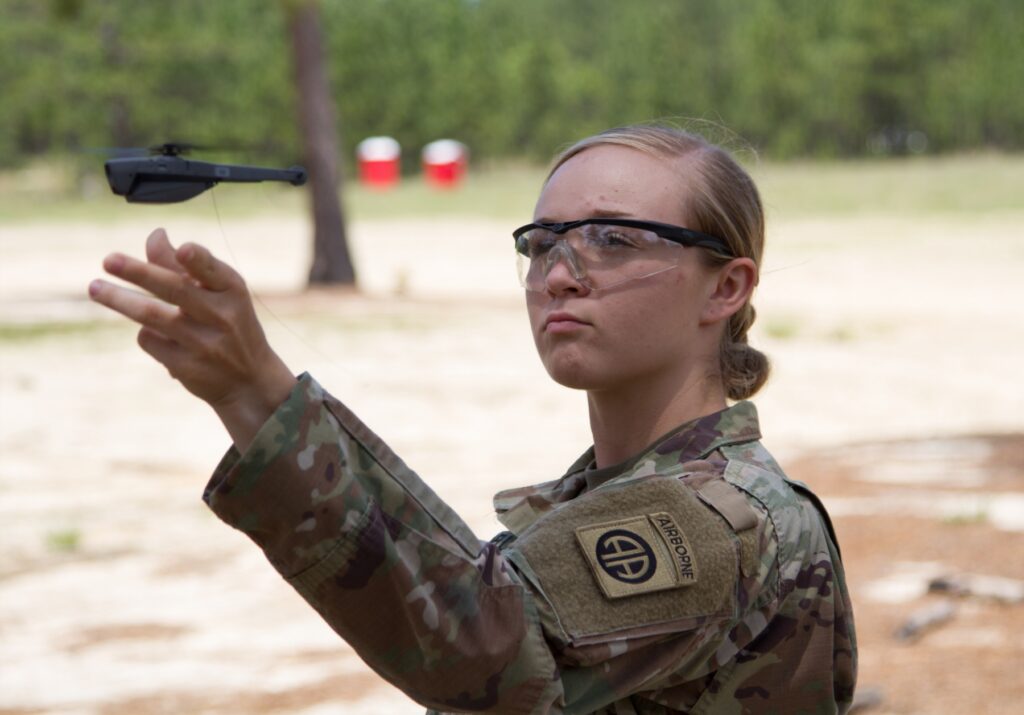
An 82nd Airborne soldier trains with a Black Hornet mini-drone before deploying to Afghanistan.
WASHINGTON: This summer, Army soldiers will deploy to Afghanistan with air support literally in the palm of their hands: the 1.16-ounce Black Hornet mini-drone. New ground robots are entering service too, next year — not to fight but to haul supplies, at least at first — but field tests have convinced the Army to issue these often-cumbersome mechanical mules to specialists and only loan them to frontline troops as needed. By contrast, soldiers are so consistently and unequivocally enthused about the mini-drones that the Army is buying 9,000 systems — each with two drones — over three years to issue to its smallest and historically most vulnerable units, nine-man infantry squads.
The mini-drone and larger robots are all part of a wider revolution in the long-suffering infantry, a revolution sparked in large measure by former Defense Secretary Jim Mattis. The Marines, Mattis’s old service, have issued upgraded 5.56 mm rifles and are adding a specialized drone operator to every rifle squad. The Army is going much farther, developing new 6.8 mm rifles, high-tech targeting goggles, virtual-reality training, and, of course, robots.
Now, none of these unmanned systems is truly autonomous, so they require a human to run them by remote control, which in turn requires a functioning battlefield network that hasn’t been shut down by enemy jamming. The FLIR Black Hornet has a lot of automated functions and only flies short missions, so you don’t need a soldier babysitting it all the time. Ground robots, however, require much more oversight, because they have to avoid rocks, bogs, tree stumps, and other obstacles that no unmanned air vehicle has to worry about and that artificial-vision software still struggles to spot. The Army is eager to improve the technology so that, instead of one soldier remote-controlling one robot, they can have one soldier overseeing a largely autonomous swarm. But even today’s limited autonomy allows for big changes on the battlefield.
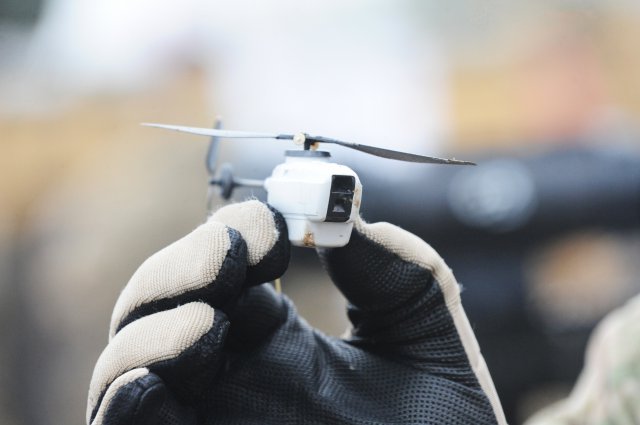
A PD-100 in a soldier’s hand, showing the front camera.
Drones For Everyone
The palmtop Black Hornet — dubbed Soldier-Borne Sensor (SBS) by the Army — is already in the hands (literally) of a brigade of the elite 82nd Airborne that’s about to deploy to Afghanistan. The second unit scheduled to get the mini-drone, starting this fall, is the 1st Security Force Assistance Brigade, which has already served in Afghanistan.
For the first time, a squad leader will have the ability to scout ahead by air before exposing human soldiers on the ground. The SBS has sensor options for both night and day, and it can fly about 20 minutes before needing to recharge.
But the squad-level mini-drone is just the entry model. Larger units will get larger, more capable, but also more expensive and more maintenance-hungry drones.
“Our vision is every echelon has unmanned aerial systems,” said Don Sando, civilian deputy to the commander of the Army’s infantry and armor center at Fort Benning, Ga. “The question is, how many?”
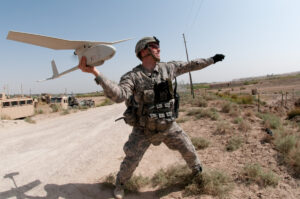
An Army soldier launches a Raven hand-held drone in Iraq.
While squads get the Black Hornet SBS, platoons will get the slightly larger Short-Range Reconnaissance (SRR) drone, Sando and other Army officials told reporters in a conference call last week. A series of tests this month, September, and January will whittle six SRR competitors down to one that will enter service in April 2020. The winner must weigh three pounds or less, fly for 30 minutes, and be able to “perch and stare,” landing in a vantage point overlooking a target area so it can keep watch without burning through its flight time.
Companies will stick with the current RQ-11 Raven, which is still small enough that soldiers launch it by picking it up and throwing it.
Battalions currently use the Raven as well, but the Army plans to develop a new Long-Range Reconnaissance drone for them to use. The LRR isn’t an official program yet, however.
Brigades currently have the RQ-7 Shadow, but that aging system needs a catapult to launch and a runway to land. It will be replaced by the Future Tactical Unmanned Aerial System (FTUAS), which takes off and lands vertically like a mini-helicopter, starting in 2021.
Divisions currently use the Grey Eagle, a variant of the venerable Predator, but the Army is experimenting with potential Advanced UAS drones to replace it too.
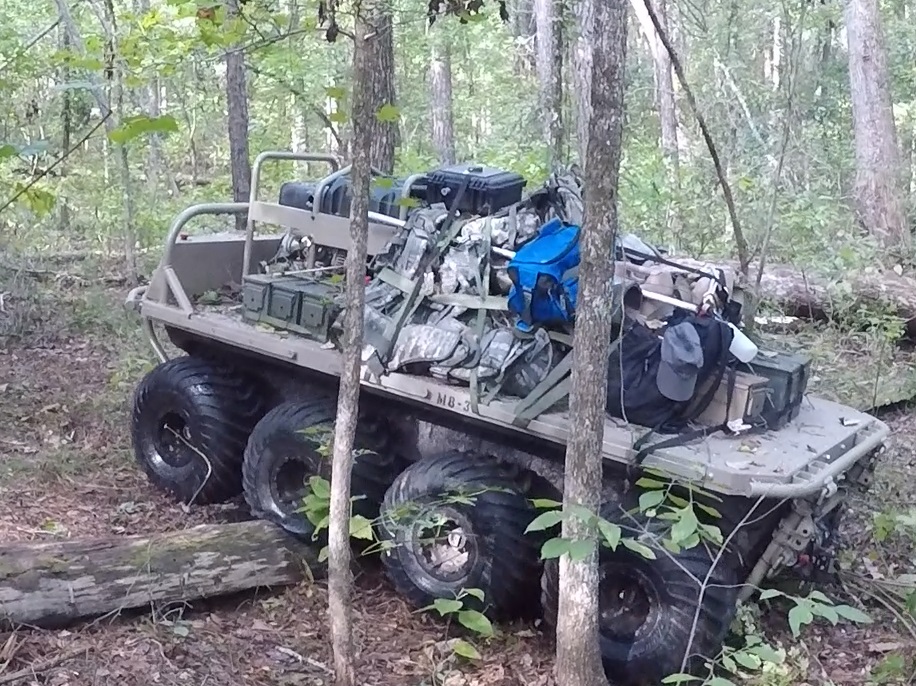
The General Dynamics contender for the Army’s new robotic mule, the SMET (Small Multipurpose Equipment Transport)
Ground Bots For Some
The Army is also fielding ground robots, but these machines are still much clumsier and harder to work with than aerial drones, so they’re being issued only to specialist units. That includes what was formerly called the Squad Multipurpose Equipment Transport but is now renamed the Small Multipurpose Equipment Transport, because it’s not going to belong to an individual squad.
The SMET, by either name, is still a small unmanned ground vehicle, about the size of a golf cart, designed to trundle along with the foot troops, hauling supplies and gear like an old-fashioned pack mule. It must carry 1,000 pounds of supplies and gear over 60 miles in 72 hours, trundling along with foot troops, and provide three kilowatts of power to recharge batteries for night vision goggles, radios, and other electronics.
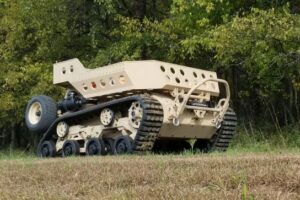
Howe & Howe Grizzly
Four competitors remain in contention: the Polaris MRZR, Howe & Howe Grizzly, HDT Wolf, and General Dynamics MUTT. “They’re all viable candidates. They all met the standards of range, offloading power, silent watch capability, payload carrying,” Sando said. “Soldier feedback on all of them was very comparable with regard to what missions they’re good for — and what conditions they’re not appropriate for.”
The Army plans to field the winner starting next year to selected training centers, combat brigades, and support companies — but not infantry squads. “We found out in the operational tech demonstration [that] it can best be supported now at the battalion level,” Sando said, which is the lowest echelon of an infantry unit to include technical specialists such as a heavy weapons company. The Army’s objective is to incorporate the new technologies without adding personnel to take care of them.
The issue with SMET is not just the maintenance the robots require — though that can be a large burden for a squad of nine — but also their limited mobility. “There are places where we ask our soldiers to go where nothing else can go… jungle terrain, steep embankments, water, and dense urban environments,” Sando said. “There are areas soldiers can walk and crawl and climb that we just couldn’t put a vehicle of this size with them.”
The SMET remains very useful for long marches with heavy loads, the bane of infantry soldiers increasingly overburdened by body armor, ammunition, and electronics. Being able to recharge gear from the robot instead of carrying several days’ worth of batteries for every item of equipment is itself a significant reduction in weight. Future SMET variants, Sando said, might carry long-range sensors, communications relays, or even weapons.
But when foot troops have to go places you can only go on foot, they need to be able to leave the robot vehicles behind and let someone else take care of them. By contrast, Sando said, “the Soldier-Borne Sensor is smaller than a pack of cigarettes, [so] I can use it when I need it, I can put it back.”
Edited Monday 10:40 am to clarify there are two drones per Soldier-Borne System (SBS).
Subscribe to our newsletter
Promotions, new products and sales. Directly to your inbox.
